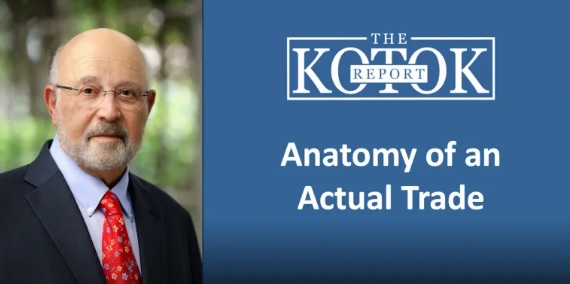
(Please note: The Kotok Report is now also available on Substack at https://dkotok.substack.com.)
First, a disclosure. Today’s missive is a reference to an actual trade that was done in my personal account. I’m using it as an example of possible market dysfunction in the present regime and as an example of how, for me, that presented an opportunity to seize the pricing. I will explain the rationale below. I did the trade in my personal account through the assistance of Cumberland Advisors. For information about Cumberland go to www.cumber.com. My role at Cumberland is as an independent consultant and strategic advisor. Now here’s the trade and rationale.
PLEASE NOTE: This missive is prepared and published before this week’s US Treasury note and bond auctions.
Here’s the bond description of the bond I purchased. These details are a screenshot of those reported via a Bloomberg terminal.

Now to the rationale and explanation.
The bond pays an interest rate of 5.18%, and the interest is tax-free for federal income tax purposes. I’m ignoring state income taxes for this analysis. The security for the bond is a collateral basket of mortgages held by a state housing agency (Alabama) and backed by GNMA (direct US government guarantee) or FNMA or FHLMC (both federal agencies). The rating of the bond reflects the credit rating downgrade of the US Treasury and is Aa1. Aaa ratings on the United States no longer exist.
At a 37% federal income tax rate, the taxable equivalent yield for this 5.18% tax-free bond is 8.22%. In other words, assuming a 37% tax bracket, if I loaned money with the identical terms and payment arrangements as in the underlying mortgages and I were fully taxed on the interest, I would need an 8.22% interest rate to “break even” with the tax-free bond I purchased.
So, was the bond a cheap or richly priced one?
For some readers this answer may seem a little technical, but bear with me. In bonds, we use the calculation of “duration” in order to value all of the cash payments in a bond. Remember that most bonds are paying interest twice a year and then principal at maturity or earlier if called. With housing bonds, the situation is even more complex because there are some prepayments that occur when mortgages are paid off for any one of several reasons. Death, divorce, or relocation of the homeowner are examples of prepayment reasons. And there is refinancing if the interest rate of the new mortgages market changes and the borrower can refinance at a lower rate. We call that the prepayment speed risk, and there are mathematical ways to estimate it.
Anyway, the 10-year US Treasury note is about the closest reference we have for a duration match with this bond that I purchased. On the day I bought my bond, the 10-yr Treasury note closed at a yield of 4.36%. For reference only, the 30-yr Treasury bond closed at 4.88% on the same day. I offer that reference only to demonstrate that this 30-year tax-free bond is paying me 30 basis points more than the 30-year taxable US Treasury bond would.
Let’s compare with the duration match. I get 5.18% tax-free. The holder of the 10-yr Treasury note gets 4.36% and pays taxes on that interest. Unless, of course, the holder is a pension plan or a foreign institution or other investor who doesn’t pay taxes.
Am I worried about a default? No. I have the guarantee of the US government or its agencies in addition to the security of the actual mortgages on the houses that are mortgaged.
What if I were worried about a default? Well, the 10-year credit default swap (CDS) on the United States was trading that day at about 57 basis points. I could have bought that derivative insurance if I had wanted to do so.
Let’s examine this anatomy: 5.18% tax-free and backed by the creditworthiness of the United States. Cost of insurance with CDS was 57 bps. So, after the CDS cost, I could have had a net return, tax-free, of 4.61%. Meanwhile, the duration-matched 10-year T-note was 4.36%.
My conclusion? Even a foreign investor or non-taxpaying US pension trust would have been better off with the tax-free bond than with the US Treasury note. And remember that for those allocating money to private equity investments or other taxable forms of investment, the taxable-equivalent return to match this is 8.22%. And at 8.22% you would still have the pledge of the payment to you backed by the US government.
Is this an example of a dysfunctional market pricing? That is up to each investor to decide.
For me, this was easy. I bought the bond. And I didn’t buy the CDS.
This technical note applies: The CDS would only cover a US Treasury default and not the federal agencies. So, if you’re worried about a default of a federal agency, whether a lease or a FNMA mortgage, the CDS offers you a way to get insurance on the US Treasury, which is where the federal government has to turn to make good on any of its guarantees.
David R. Kotok, June 10, 2025
(The above was first published on The Kotok Report website and via LISTSERV. For details, and to subscribe to The Kotok Report, visit https://kotokreport.com/.)
